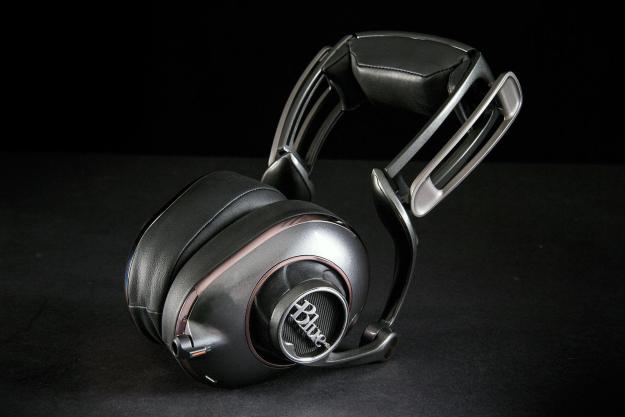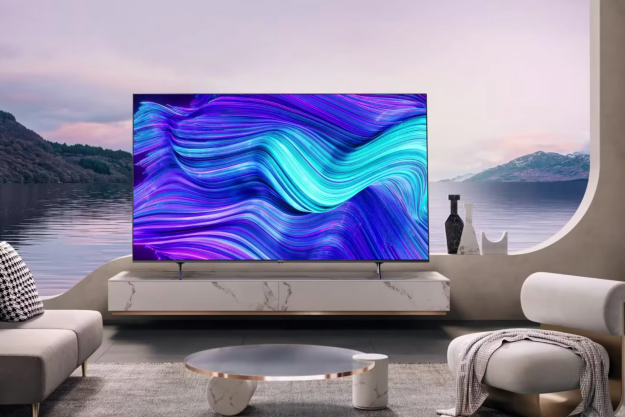
“Blue Microphones’ Mo-Fi are remarkably well-balanced, dynamic and detailed headphones, but their weight and bulk precluded long-term comfort for us.”
- Dynamic, detailed, spacious, and balanced sound
- Passive mode for use with high-end electronics
- Auto-off feature saves battery
- Long battery life
- Solid passive noise isolation
- Heavy
- Some learning curve involved
- Fatiguing after long-term use
- Don’t fold down for travel
Blue Microphones’ Mo-Fi are remarkably well-balanced, dynamic and detailed headphones, but their weight and bulk precluded long-term comfort for us.
One look at Blue Microphones’ Mo-Fi Powered Headphones, and it’s clear they are not just another headphone. Dig in a little and you’ll find that a lot of consideration by some very clever and experienced engineers went into the design and development of these things. Shoot, they could easily have been designed by NASA engineers, for all we know. Except we actually know better.
The folks behind the Mo-Fi, including former Monster product guru Mitch Witten, set about designing these headphones by attempting to address all the problems most other
You’d think, then, that the product of that kind of focused genius would result in a slam-dunk set of cans. But as we found out over the course of over a month of using the Mo-Fi, that isn’t exactly the case. Yes, the Mo-Fi sound great – really, really great — but is it possible Blue overthought their design?
Hands on video
Out of the box
The Mo-Fi are presented like a gourmet meal on a dome-covered silver platter. The top of the cube-shaped box is really just a giant lid that conceals the Mo-Fi, sitting upright in a custom cut tray underneath. The unboxing experience forces to you take a pause to fully absorb what you’re looking at.
The Mo-Fi are presented like a gourmet meal on a dome-covered silver platter.
For us, the Mo-Fi come off as part Steampunk, part TRON. It was hard to figure out if we were going to look cool or ridiculous while wearing them – they’re just so big and elaborate-looking. To be sure, the Mo-Fi will get you looks anywhere you wear them. Figuring out whether you’re being mocked or admired is just part of the adventure.
The Mo-Fi currently come in just one color, which is a sort of gunmetal grey. Accompanying accessories mirror the shiny grey look at the tips, including a 1.5-meter iPhone-friendly cable with inline mic control, 3-meter standard cable, and 3.5mm to ¼-inch TRS adapter. A 1-meter USB charging cable, AC charging adapter, airline adapter, and a soft case with cable storage pocket are also included.
Features and design
The Amp
The Mo-Fi’s two standout features are their on-board amplification, and their suspension system (because “headband” is just too pedestrian, mmmkay?).
The idea behind the on-board amplifier is simple: The force is weak in your mobile device’s built-in headphone amplifier. Smartphones and tablets are designed to be phones and tablets first, and music players a rather distant second – at least when it comes to hardware. Even laptops these days are pretty lame in this department. The Mo-Fi attempt to address this problem by packing their own amplifier wherever they go.
By using a high-quality amp in the headphones, Blue was able to use high quality, power-hungry 50mm drivers that a phone or tablet just couldn’t hope to adequately power on its own. In theory, this amp should allow for more headroom, higher dynamics, better overall clarity, and a better balanced response.
The amplifier at use in the Mo-Fi has two modes: Standard and Bass Boost. It can also be turned off entirely when you have access to an outboard headphone amplifier to do the work – or have simply run the batteries dead.
To prevent that from happening prematurely, Blue has cleverly designed the headphones to power off after a short period of inactivity. The amp section powers back up automatically when the
Headphone suspension
Blue has cleverly designed the headphones to power off after a short period of inactivity.
Check out our hands-on video above for a close look at how the Mo-Fi use a variety of hinges and springs to create a customizable suspension system. As you’ll see, they move in a number of different directions at all the right places to create a custom fit, no matter the shape of your ears or head.
At the top of the headphones, where pad meets crown, you’ll find a dial that adjusts the Mo-Fi’s clamping force. This allows the Mo-Fi to adapt to a variety of head sizes, sure, but the intention here is to allow the user to balance clamping force with gravity to make the
Audio performance
The best thing about the Mo-Fi, by far, is their sound quality. We don’t trot out the “rediscovering your music collection” line very often (or lightly), but that notion certainly applies here – especially since the Mo-Fi allow music lovers to do it without changing the way they listen.
Let’s face it: Most folks listen to music with their phones and laptops these days, and that isn’t going to change any time soon. The Mo-Fi promise a better listening experience without any additional equipment, and they deliver on that promise.

The less you push your phone, tablet or laptop’s volume dial up, the less distortion you introduce into the signal. The idea behind the Mo-Fi is that you don’t have to use your device’s power to boost the signal to the volume level you want. Rather than tax your device, just turn down its volume dial, turn the Mo-Fi on, and adjust your device up or down until you’re happy with the volume level. The Mo-Fi’s fully analog amp takes the incoming signal and re-amplifies it, driving the two 50mm drivers in each ear cup. In this way, you don’t have to ask your device to do much at all to amplify the signal.
The results are impressive. The Mo-Fi are remarkably dynamic, well-balanced and detailed. We enjoyed their flavor of sound quite a bit, which exposes plenty of nuances across the entire spectrum without calling undue attention to themselves. Sibiliance? Never a problem. Booming bass? Not unless we asked for it. Overall, we loved the Mo-Fi sound. It was a treat to listen to streaming services like Spotify on the go, yet feel like we were actually listening to high-quality audio files through a fancy DAC and headphone amp.
The best thing about the Mo-Fi, by far, is their sound quality.
You can count on a great seal from the Mo-Fi, thanks to their memory foam ear pads. The superior seal not only contributes to solid sound quality, but above-average noise isolation.
A few challenges come along with having an amplified headphone, though. Make the wrong move, and you could be headed for some hearing damage.
It’s hard to overstate just how loud the Mo-Fi can get. It is imperative that you reduce your device’s volume to a minimum before turning on the Mo-Fi and pressing play, otherwise you could be in for an ear-splitting blast of sound. Similarly, you don’t want to disconnect or connect the Mo-Fi to any device while they are turned on. Doing so causes an extremely loud pop which can be pretty comfortable.
Comfort
It doesn’t matter how good a pair of headphones sound if you don’t enjoy wearing them, or can at least tolerate them for an extended period of time. Unfortunately, this is where we struggled with the Mo-Fi. While we acknowledge that fit and comfort are very subjective issues, the Mo-Fi’s bulk and weight are going to cause issues for a lot of people.
We simply had too much trouble coming up with the right clamping force setting. Too much and we felt too much like our head was locked in a vice grip. Too little, and eventually the small pad at the top of the Mo-Fi would begin to make the top of our head sore. As we write this section of the review, we’ve worn the headphones for about 3.5 hours (with a couple of 2 or 3 minute breaks) and we’re about ready to be done for the day. This might not work out well for travelers or office workers looking for a set of cans to get them through the workday, or a long flight or train ride.
But the sound – the unmistakably good sound – begs us to come back. But we’d rather find a more comfortable pair of headphones and add a little outboard headphone amp than struggle with the Mo-Fi’s weight on the long term. It’s a tough call, and you might not feel the same, but that’s where we stand.
Conclusion
Blue Microphones Mo-Fi headphones present a challenging proposition for buyers. From a sound-quality perspective, these
Score: 
Highs
- Dynamic, detailed, spacious, and balanced sound
- Passive mode for use with high-end electronics
- Auto-off feature saves battery
- Long battery life
- Solid passive noise isolation
Lows
- Heavy
- Some learning curve involved
- Fatiguing after long-term use
- Don’t fold down for travel











